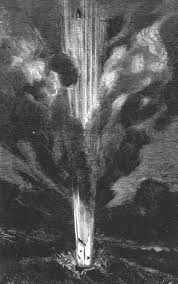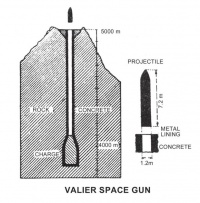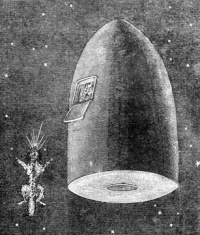Jules Verne and Astronautics by Ron Miller
From The Space Library
A lot is made of how prophetic science fiction is supposed to be. And it certainly has seemed to hit the mark pretty often and pretty remarkably. But some of its most impressive hits depend on just what you mean by "prophecy."
There are, it seems, four ways in which science fiction can appear prophetic.
1. The author just makes things futuristic by simply making them bigger, smaller, faster, etc. but doesn't in fact come up with anything really new. 2. Wishful thinking, i.e.: "This author says his machine is run by a mysterious force so he must be talking about atomic power!" 3. The author genuinely invents something entirely original, such as when Gernsback accurately described radar in 1911. 4. The author's prophecies are self-fulfilling. This is what most often occurs with Jules Verne. He didn't so much predict the future as to cause it to come true. His classic space travel novel, From the Earth to the Moon, is a perfect example of this.
This book has probably been the subject of as much critical scrutiny as any novel Verne ever wrote. It has been fashionable in the last few decades—especially since the beginnings of the Space Age—to look back sneeringly at Verne's science. One well-known science fiction author, who truly ought to have known better, referred to the speculations in From the Earth to the Moon as " ...the kind of pseudoscience that gives science fiction a bad name. Everything, including Verne's elaborate calculations, is completely wrong ...Verne was very proud of this novel and of its scientific accuracy, which is a good measure of Verne's almost total lack of knowledge about science." Yet Wernher von Braun, the father of the Saturn 5 moon rocket, said that " ...the science in From the Earth to the Moon is nearly as accurate as the knowledge of the time permitted...he was read with great respect by working scientists, so carefully did he do his scientific homework." Von Braun concluded that "...the debt modern astronauts owe [Verne] is apparent."
Why such a disparate dichotomy in opinion concerning the science in this novel? The "error" in From the Earth to the Moon that is inevitably singled out is the use of the giant cannon for launching the manned projectile. Rightly so: it simply would not have worked—at least as described by Verne. Going from a standing start to escape velocity (about seven miles per second) in just 708 feet would subject the projectile's passengers to a force of nearly 30,000 g. Barbicane, Ardan and Nicholl would have been spread into a thin coating on the floor of the projectile. This is not the worst of it: there is the air within the bore of the gun to contend with. Above the projectile is a column of air 708 feet high and 9 feet wide; there is simply no way that this mass of air could get out of the way of a 10-ton projectile moving at several times the speed of sound. The gases would be compressed into a virtually solid body. The projectile would be trapped between the white-hot blast below and the white-hot compressed air above. The projectile, instead of shooting to the moon, would instead have showered central Florida with a rain of molten aluminum.
But is this "mistake" indeed an error on Verne's part? Did he really not know any better? There is no direct evidence to the contrary, but there is a great deal of internal evidence that Verne, indeed, knew exactly what he was doing. The immediate question is: if Verne was trying to write a novel showing how it might be realistically possible to reach the moon, what other methods had he at hand? With the self-imposed limitation of using only contemporary technology, thereby eliminating such utterly imaginary devices as antigravity, his only other choice would have been the rocket. That he was aware of the possible uses of rockets in space, and that they would function in a vacuum (something few, if any, other science fiction authors, and fewer scientists, seemed to be aware of), is illustrated by his use of rockets for steering the projectile. Why then, his critics will ask, did he not use them for the entire journey? The reason is that Verne was not only striving for accuracy, but believability. He was certainly aware that all the accurate details in the world were for naught if no one believed them. And that was the problem with the use of rockets. And, of course, if Verne had not employed a giant cannon, he would have lost all of the book's sharp satire, which was one of the driving forces behind its creation.
The largest more or less consistently successful rockets built up to the time Verne was writing were the war rockets of Britishers William Congreve and William Hale. It is Congreve's rockets that we sing of in our national anthem, "...by the rocket's red glare, the bombs bursting in air...," when they were used against Fort McHenry in the War of 1812. The largest of these were 6.5 inches in diameter (42-pounders) with a maximum range of 3,000 yards. Congreve designed rockets with 8-inch diameters and weighing up to 1,000 pounds. These never saw service because they were then considered too heavy and impractical. Hale's rockets, developed from the 1840s onward, had ranges of up to 2,200 yards. These rockets may have been more accurate and more reliable than Congreve's, but they were still, fundamentally, skyrockets.
To have used the rocket principle in getting his characters to the moon, Verne would have had only two options: making his spacecraft a single enormous powder rocket, or making a compound rocket by combining literally tens of thousands of individual rockets (as the British Interplanetary Society did in their original moon rocket design of 1939). Either plan would have been thoroughly ludicrous—not only from a practical point of view, but also to readers to whom a rocket was little more than a toy. But people did believe in the seemingly limitless power of the modern cannon. As Verne was careful to point out, the decade immediately preceding his book had seen incredible advances in the art of artillery. One of Dahlgren's largest guns was capable of throwing a 100-pound shell 5,000 yards, Rodman's Columbiad shot a projectile weighing 1,000 pounds six miles. There seemed little limit to the size of the gun or the shell it could launch. That Verne was aware of many of the difficulties inherent in his scheme is evidenced by the care with which he "answers" the very questions raised by the critics of this century. To this end he introduces a major character whose sole purpose is to voice these doubts, allowing Verne, through his other characters and the action of the story, to respond with believable (if imaginary) solutions. That this character criticizes the moon venture in virtually the same terms as do Verne's later critics simply shows that Verne himself was aware of these problems. It also puts into the mouth of a character—and an unlikeable one at that—the very objections which may have been forming in the mind of the reader.
Among the objections raised by this character, Captain Nicholl, are: that it would not be possible to cast a 900-foot cannon, that it would not be possible to safely load it (or if it were, that the weight of the projectile itself would detonate the charge, that the Columbiad would burst when fired, and that the shell could not possibly rise more than six miles. Nicholl places a wager upon each of his exceptions and Verne, in the course of the story, has Nicholl lose each bet, one after the other. Verne has other methods of adding verisimilitude to his story. Aware that even his most innocent reader might question the effects on the human body caused by such a violent launch, Verne has his gun work by simply making it work, by fiat. His precautions against the forces of the launch are so detailed that the average nineteenth century reader would simply take it for granted that Verne was aware of the dangers and had adequately prepared for them.
Verne could be even more subtle than this. Before the launch of the human astronauts, Barbicane and Co. load a cat and a squirrel into a hollow shell. They are fired from a mortar several thousand feet through the air, finally dropping into the waters off Pensacola. When the shell is recovered, the cat leaps out unharmed (the squirrel, however, did not survive the hungry cat). "After this experiment," writes Verne, "all hesitation, all fear vanished; besides, Barbicane planned to work further to perfect the projectile and to eliminate entirely the internal effects of the firing." All hesitation and all fears of the reader vanish as well, which is Verne's real purpose for this episode. To "eliminate entirely" the effects of the launch, Barbicane installs a shock absorber in the floor of the projectile. This consists of a layer of water three feet deep on top of which floats a wooden disc. The disc fits the inside of the projectile closely, like a piston. The water beneath it is separated into three additional layers by two thinner discs, each designed to rupture in its turn at the time of the takeoff. In escaping, the water is to be forced through a system of pipes, where it is ejected from near the projectile's nose (lightening the vehicle at the same time). The astronauts also plan to lie prone upon the disc on thick mattresses.
A number of prominent space and rocket scientists have, since the original publication of From the Earth to the Moon, amused themselves by developing variations on Verne's space gun by which it might be made to work. Max Valier, in his book Der Vorstoss in den Weltenraum—eine technische Moglichkeit [1924],carefully analyzed the Gun Club's project. His conclusion, after several pages of mathematics, was that what was needed was a lead-filled tungsten-steel projectile 21.5 feet long and 3.5 feet wide. Valier's gun would, like Verne's, have a barrel 900 feet long. This one, however, would have to be situated on the equator at an altitude of 15,000 feet. The barrel would be cast in concrete with a rifled steel lining. Before the launch, the air would be evacuated from the gun and its muzzle sealed by an airtight disc. At the moment of firing, the small amount of residual air ahead of the projectile would be sufficient to blow off the cap before the projectile reached the opening. There would be no possibility of carrying human passengers.
Somewhat later, the Baron von Pirquet examined the problem. He made the required mountain 20,000 feet high, placing even more of the earth's atmosphere below the gun. Finding that the gases from the detonating explosive would not expand fast enough if the whole charge were placed in the bottom of the gun, he placed most of the charge on the bottom of the unmanned projectile itself. He also supplied supplementary firing chambers along the length of the barrel (as did Le Faure and de Graffigny in their multi-volume novel, Aventures Extraordinaires d'un Savant Russe, 1889). Others, such as Konstantin Tsiolkovsky (who in 1895 expressed the opinion that a gun several kilometers long, placed horizontally, might work if the astronaut were immersed in liquid at the time of launch) and Antonio Stefano (who thought a projectile 150 mm in diameter would need a gun only 800 meters long), also attacked the question of Verne's gun. There have also been, of course, fictional space guns other than Verne's. For instance, H.G. Wells' Martians in War of the Worlds launched their war-machine-filled projectiles to Earth from giant cannons on the red planet. Other early science fiction novelists who have used space guns in their books include F.A. Radley (The Green Machine) and G.A. Zulawsky (In the Silver Sphere, 1911).
There have also been serious proposals for actual space guns and in recent years a gun firing instrument-carrying shells into the stratosphere has actually been tested. As early as 1924, a serious proposal was made for sending a passenger-carrying projectile into space by means of a gun. The gun would have been 3.4 miles long and mounted vertically. At the bottom was a concrete detonation chamber. The torpedo-shaped projectile was to be equipped with an elaborate system of springs and hydraulic shock absorbers, with a two-foot thick armored disk at the base.
At bottom, Verne's accurate foretelling of space travel and its problems far outweighs any errors he may have made in the telling. There are many other legitimate "firsts" Verne could claim for this novel. It is the first approach to spaceflight on a mathematical basis; indeed, From the Earth to the Moon can be rightly considered the grandfather of astronautics. Verne was the first to approach the problem of space travel on realistic physical and mechanical terms. He was the first author to appreciate the necessity of reaching escape velocity to leave the earth. He had a cousin who was a professor of mathematics work out all the calculations for escape velocity and the trajectory the projectile was to follow. It was the first time anyone had done this. Indeed, the calculations are so detailed that Russian space historian R.A. Rynin was able to recreate the actual trajectory followed by the projectile.
It would hardly be too much to say that in doing this Verne literally invented the science of astronautics.
Verne also correctly understood the operation of rockets in the vacuum of space and was the first to seriously suggest their use there (although Elbert Perce in his Gulliver Joi of 1851 has precedence). Verne was aware of many of the special needs of space travelers and allowed for them; and he described the effects of weightlessness (though he was wrong in explaining its cause).
Verne chose a site for his launch in Florida that is only 137 miles from Cape Canaveral. Nor was this a coincidence; Verne chose this site for at least one of the same reasons NASA did (its proximity to the equator). Verne was also cognizant of the many social and economic effects a space program would initiate; he even described the commercialization of his moon launch. Verne was also one of the first to suggest the possibilities of "light...as [a] mechanical agent" for spaceship propulsion. From the Earth to the Moon has been enormously influential on the history and development of rocketry and spaceflight. Tsiolkovsky, the great Russian theoretician who laid a great deal of the mathematical groundwork for modern astronautics, said, "Possibly the first seeds of the idea were sown by that great fantastic author Jules Verne—he directed my thinking." Hermann Oberth, "the father of the V2," wrote, "I always had in mind the rockets designed by Jules Verne." We've already mentioned von Braun's expression of debt. Other space pioneers Verne influenced include American rocket inventor Robert H. Goddard; Russian rocket engine designer Valentin Glushko (who wrote that "at the age of thirteen, while studying at a technical school, I read two books by Jules Verne...which shaped my life-long interest"); cosmonaut Yuri Gagarin, the first man into space; and astronaut Frank Borman. Astronomer Robert Richardson, in Man and the Moon (1961), wrote, "There can be no doubt that Jules Verne's Trip to the Moon with all its faults has exerted a powerful effect on human thought in preparing our minds for this greatest of all adventures." And Arthur C. Clarke, himself no amateur at prescience, said, "I'm sure we would not have had men on the moon if it had not been for Wells and Verne and the people who write about this and made people think about it."






